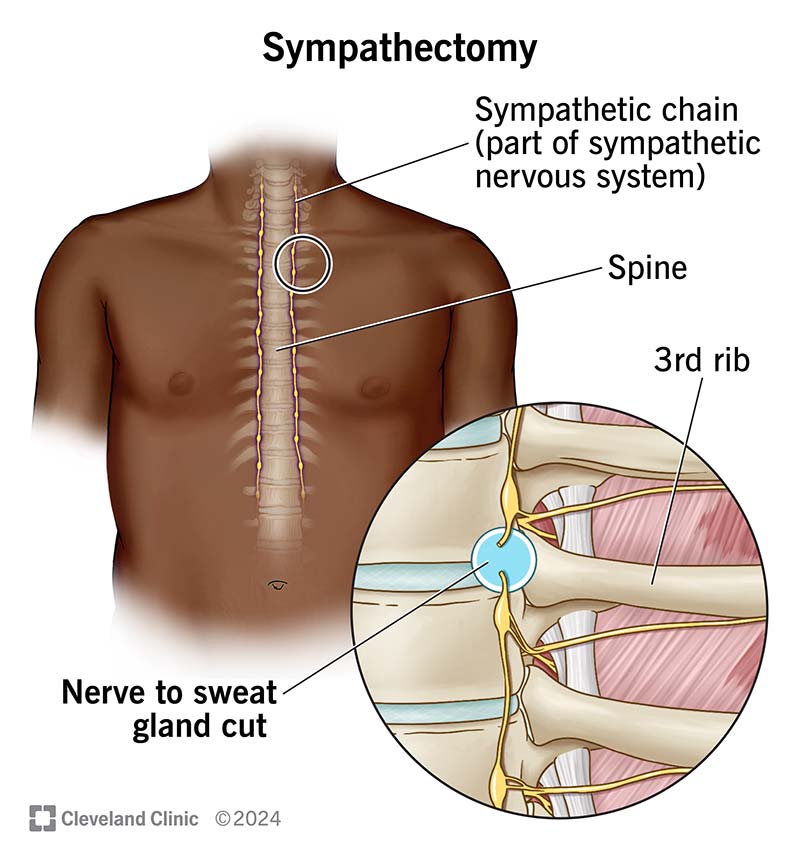A sympathectomy is a nerve-cutting surgery often used to treat excessive sweating when other options haven’t worked. It offers permanent results and may greatly improve your quality of life. Recovery is fairly quick, but side effects are possible. Talk with your provider about the risks and benefits.
Advertisement
Cleveland Clinic is a non-profit academic medical center. Advertising on our site helps support our mission. We do not endorse non-Cleveland Clinic products or services. Policy

A sympathectomy is a rare, minimally invasive surgery that cuts certain nerves in your sympathetic nervous system. This system controls automatic functions that you don’t have to think about, like sweating. By cutting the nerve, this surgery blocks a signal that triggers an automatic function in a specific part of your body.
Advertisement
Cleveland Clinic is a non-profit academic medical center. Advertising on our site helps support our mission. We do not endorse non-Cleveland Clinic products or services. Policy
Surgeons usually do this procedure to stop the nerve signals that trigger excessive sweating (hyperhidrosis). For example, to treat this condition in your hands, arms or feet, a surgeon will cut a nerve in your chest.
Providers can use this procedure to manage the following conditions:
This type of surgery is uncommon. It’s typically only done when other treatments for these conditions haven’t worked.
You’ll meet with your surgeon before the day of your procedure. They may schedule tests, like blood tests and a chest X-ray, to check your overall health and plan for the operation.
Your provider will give you specific instructions to follow. This may include guidance on what you should or shouldn’t eat or drink the night before surgery. If you smoke, you should cut back or stop smoking.
They may also tell you to stop taking certain medications before the procedure (like a blood thinner) if that’s part of your daily routine. Don’t make changes to your medications unless your provider tells you to do so.
You should also arrange for someone to drive you to and from the hospital.
Advertisement
The steps vary slightly based on what your surgeon is treating.
This surgery happens under general anesthesia. An anesthesiologist will put you to sleep so you won’t feel any pain.
The procedure is minimally invasive. Your surgeon may use robotics or thoracoscopic surgery.
To treat hyperhidrosis, a surgeon will:
If excessive sweating occurs on both sides of your body, your surgeon will work on one side at a time.
Your surgeon will have the best time estimate. It varies based on what they need to do and your underlying conditions and surgical history. Generally, it can take one to two hours.
The benefits of a sympathectomy may include:
This procedure usually works well to reduce sweating in your hands and armpits.
You may need a second surgery if hyperhidrosis returns on one or both sides of your body. This may happen if the initial nerve cut was incomplete or if sweat signals reroute through nearby nerves.
As with any type of surgical procedure, there are potential side effects. These may include:
Side effects specific to a sympathectomy to manage hyperhidrosis may include:
A sympathectomy usually can’t be reversed. But it may be possible in some situations. You might consider reversal (if possible) if you develop severe sweating in other parts of your body after the procedure.
After the procedure, you’ll move to an area of the hospital for observation until the anesthesia wears off.
In most cases, you can go home the same day. You’ll need someone to drive you home. In some cases, you may need to stay overnight at the hospital. Your provider will let you know what you can expect.
Advertisement
You’ll likely experience some pain following surgery. You may also have some tingling or numbness. This should get better in the first few weeks. You should be able to manage it with medicines like NSAIDs or a prescription your provider gives you.
Follow your provider’s instructions after surgery. This may include how to care for the incision site, when to come back for a follow-up appointment and what activities are safe to do.
Recovery time depends on the type of procedure you have. The incision site usually takes a few weeks to fully heal.
Take it easy for the first few days after surgery. Most people can return to normal activities within one to two weeks. Your provider will let you know when it’s safe to continue all physical activities.
You can shower, but avoid baths or swimming for at least two weeks. Don’t do strenuous exercises or lift heavy objects until your provider gives the OK.
Contact your provider if you develop signs of infection, like:
You’ll have a follow-up visit a couple of weeks after surgery, then several more during the first year. After that, you’ll likely have yearly check-ins for up to five years.
Advertisement
Most people don’t realize how tough it is to live with excessive sweating. But you do. You’ve tried other treatments, and now you’re considering one more option.
Sympathectomy helped many people in your situation. And it’s normal to have questions, especially about where sweating might show up after it stops in your hands or armpits.
Talk with your provider about the benefits and risks. They can walk you through anything that’s unclear. This is a personal decision that can affect your quality of life. It’s important to feel confident about your next step.
Advertisement
Last reviewed on 07/21/2025.
Learn more about the Health Library and our editorial process.